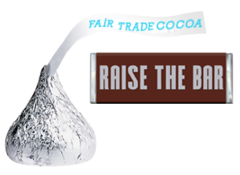
Fall is upon us, and I propose that we don’t wait until Jan. 1 to become resolute. Now is a great time to engage in a meaningful commitment, and with Halloween (a contraction of All Hallows’ Evening) just around the corner, there is just the opportunity.
In the most recent edition of YES! magazine, a publication not to be missed, one article investigates the true nature of fair trade chocolate. Another by Annie Leonard, the creator of the video Stuff that went viral six years ago, challenges us to redefine our relationship with consumption. Both topics converge on the ghoulish holiday, where cheap chocolate-like candies and kitschy commercial merchandise abound.
“The Chocolate Fix,” the first article mentioned, begins with a confession. Author Kristy Leissle, who received her PhD in a program that explored the “origins, trade, and politics” of chocolate, is a self-professed addict. Unlike the majority of chocolate lovers, her passion carries her past hedonistic indulgence to the supply chain. This might appear to take the romance out of the elixir, but only superficially so. How can a candy bar taste sweet when produced by near-slave labor, people who earn $2 to $4 a day and barely survive? Although the focus of YES! trends toward the positive and practical, other sources paint a clearer picture of what life is like for the invisible farmers of our commonplace luxury. According to UNICEF, 40% of the world’s cocoa comes from farms along the Ivory Coast, where hundreds of thousands of children are employed. A CNN investigative report from 2012 reported on one 10-year-old and states:
When Abdul’s mother died, a stranger brought him across the border to the farm. Abdul says all he’s given is a little food, the torn clothes on his back, and an occasional tip from the farmer. Abdul is a modern child slave.
To feel the full impact, perhaps one could show the video interviews to a group. Before the video begins, pass out a bag of mini Kit-Kats. It would be a mean trick, but one long past due. The purpose of the CNN investigation was to assess the effectiveness of the 2001 Harkin–Engel Protocol, also known as the Chocolate Protocol. In 2000, a number of documentaries were aired that exposed the slave labor and trafficking that defined much of the cacao industry. The Cocoa Protocol was a 6-part plan to address “the worst forms of child and forced labor.” The most telling result of the 2012 effort seems to have been, as they say, the deafening silence. The farmers in the interior of western African countries had heard nothing of the protocol, and responded often with a humble laugh of disbelief when told the selling price of their crop. On average, farmers in West Africa earn 6 percent of the final selling price of chocolate.
What I am writing is the result of reading and watching, not being on the ground. If any of this moves you, stop reading and immediately type “chocolate slavery” in YouTube.

The second article, “The Human Cost of Stuff,” packs an awful lot into 4 pages. With a deeper look than the usual but vital message of “stop consuming,” Annie Leonard chooses the example of Haitian textile workers to highlight the gross inequality between what American consumers pay and what the producers earn. The particular example concerns T-shirts being made for Disney, but the same idea is widely applicable (search “Mickey goes to Haiti” on YouTube for a bit of the magic). Even with the promise of harassment and sub-poverty wages, Haitian workers flee the desolate countryside for urban centers. Leonard links free-trade agreements, which are the scourge of the indigenous Haitian farming economy, with low-priced and disposable North American goods. Haitian workers receive “one-half of one percent of the U.S. retail price of each garment they sewed.” The chocolate workers would appear to fare quite well when compared with this model.
It is particularly sad that we hand out the products of downtrodden children to affluent children halfway around the world. A shiny wrapper may obscure the dubious origins of the Snickers bar, but it cannot silence them without our compliance. A plastic Donald Duck mask might save time, effort and the need to be creative, but it embodies none of what a holiday can be. The most important part in affecting change is to not act alone. By limiting yourself to the conscious consumer mindset you become defined solely as a consumer. True power lies in group action. Here are a few ideas for this Halloween:
• Take pride in making your own costume, and make a point of mentioning it
• Avoid the orange isle popping up in nearly every store; the byproduct of a Halloween party should be happy or possibly scared people, not a trash can brimming with orange
• Bake the seeds from your pumpkin, compost the pumpkin after the holiday
• Do more than just personally boycotting Mars, Hershey, Cadbury, etc., by reverse trick-or-treating, hand out items with a brief note
• Talk with others, encourage them
• Guerrilla labeling can be a very successful tactic. A note is secretly placed in between bars at a grocery store. The most famous example of this is the “Raise the Bar” campaign, which is directed at Hershey’s.













